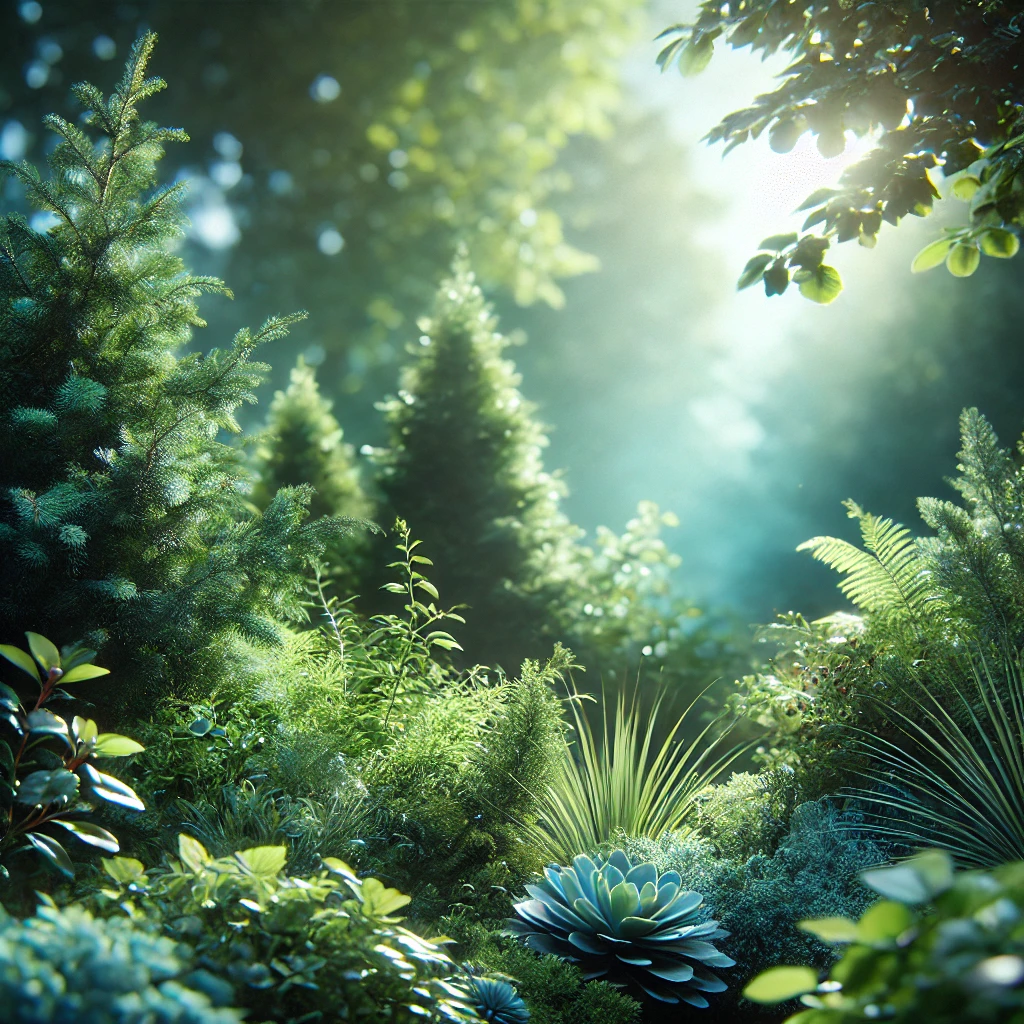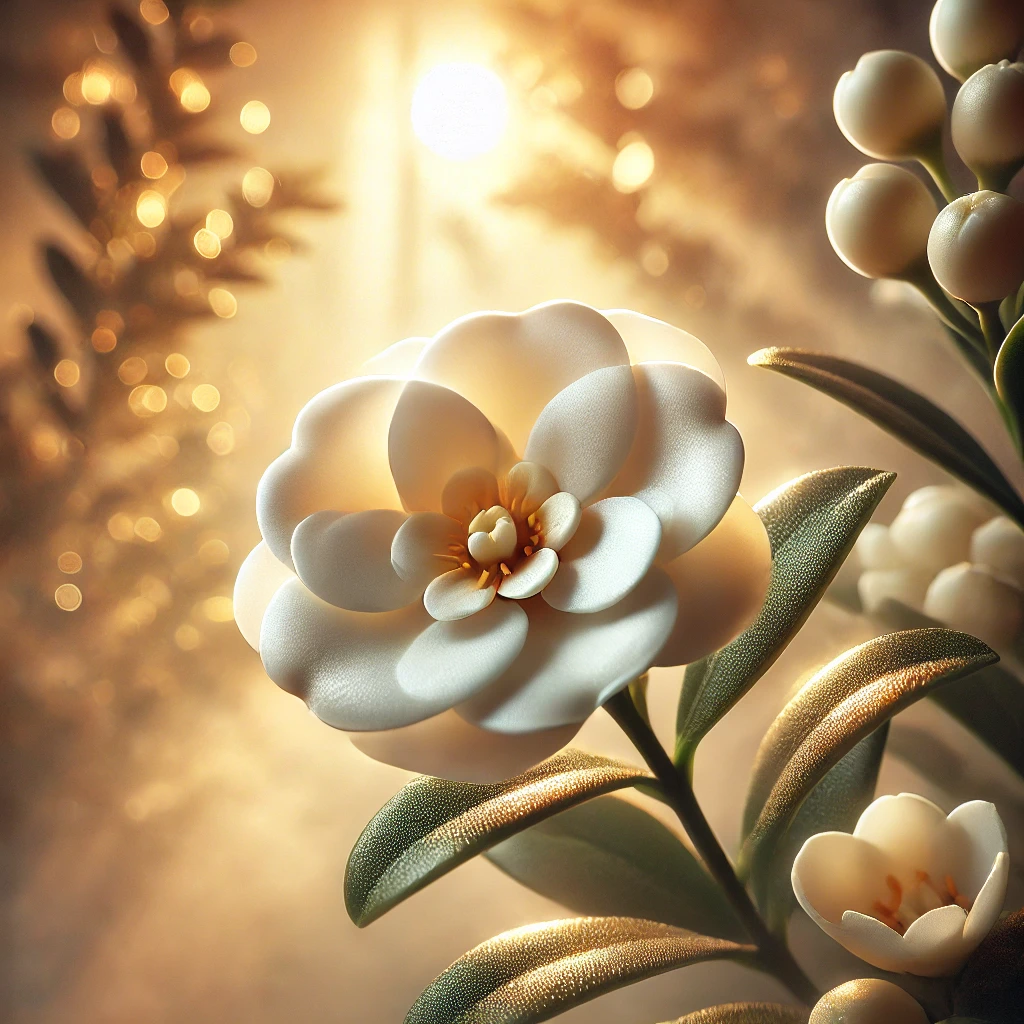Evergreen plants are nature’s gift to gardeners, providing vibrant greenery all year round. Unlike deciduous plants that shed their leaves seasonally, evergreens keep your surroundings lively and lush, regardless of the season. Whether you have a sprawling garden, a cozy terrace, or a small indoor space, evergreen plants bring aesthetic appeal, environmental benefits, and a touch of elegance to any setting. Their adaptability and low-maintenance characteristics make them a favorite for gardeners and plant enthusiasts worldwide.
What Are Evergreen Plants?
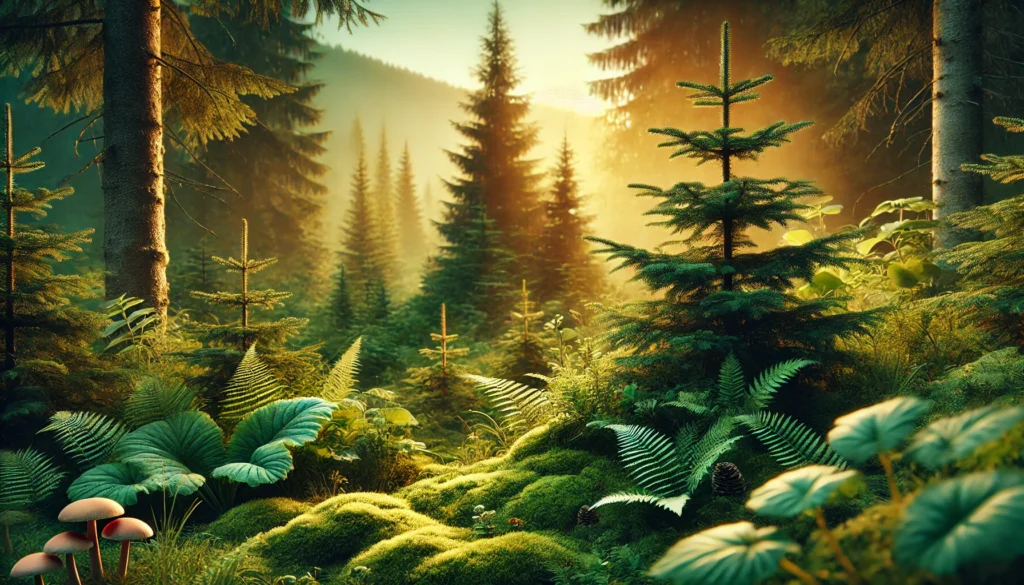
Evergreen plants are a unique category of flora that retain their leaves throughout the year, providing consistent greenery and vibrancy regardless of the season. Unlike deciduous plants that shed their leaves during specific periods, evergreen plants maintain their foliage, making them a reliable choice for year-round beauty.
Key Characteristics of Evergreen Plants:
- Year-Round Foliage:
Evergreen plants keep their leaves or needles throughout the year, ensuring a continuous green cover. - Adaptability:
They are highly adaptable to various climates, ranging from tropical regions to temperate zones and even arid environments. - Longevity:
Many evergreen species are known for their long lifespan, with some living for decades or even centuries.
Evergreen vs. Deciduous Plants:
- Evergreen Plants:
- Retain leaves year-round.
- Typically have tougher, wax-coated leaves to reduce water loss.
- Found in various habitats, including rainforests, deserts, and temperate forests.
- Deciduous Plants:
- Shed leaves seasonally to conserve water or survive harsh weather conditions.
- Usually exhibit vibrant seasonal changes, such as autumn foliage.
Evergreen plants offer not only aesthetic appeal but also practical benefits, such as reducing soil erosion, improving air quality, and providing year-round shelter for wildlife.
Types of Evergreen Plants
Evergreen Trees
Evergreen trees are towering symbols of resilience and longevity. Examples like pine, spruce, and cedar not only enhance the beauty of large landscapes but also provide numerous environmental benefits. These trees act as natural windbreakers, reduce soil erosion, and improve air quality by filtering pollutants. Their majestic presence makes them an excellent choice for parks, gardens, and large properties.
Evergreen Shrubs
Evergreen shrubs, such as boxwood, Indian hawthorn, and camellia, are versatile additions to any outdoor space. These shrubs are ideal for creating hedges, privacy screens, or even as standalone features in a garden. Their dense foliage and year-round greenery offer structure and charm to landscapes, making them a popular choice for gardeners seeking low-maintenance yet impactful plants.
Evergreen Vines
Evergreen vines like ivy and jasmine are perfect for adding vertical greenery to your space. These plants thrive when grown on trellises, walls, or as ground cover. In addition to their aesthetic appeal, jasmine vines also release a sweet fragrance, creating a pleasant ambiance in outdoor areas.
Indoor Evergreen Plants
Indoor evergreen plants, such as areca palm, peace lily, and snake plant, are ideal for enhancing your home’s interiors. These plants not only elevate the aesthetic appeal of your space but also improve air quality by filtering toxins. Their low-maintenance nature makes them perfect for homes and offices, bringing a touch of nature indoors.
Benefits of Evergreen Plants
Evergreen plants are more than just visually appealing; they provide a range of practical and ecological advantages that make them indispensable for any garden or landscape.
Environmental Advantages
- Reduce Soil Erosion: The dense root systems of evergreen plants stabilize the soil, preventing erosion and retaining moisture.
- Improve Air Quality: These plants act as natural air purifiers, absorbing carbon dioxide and releasing oxygen throughout the year.
- Provide Wildlife Habitat Year-Round: Evergreens offer consistent shelter and food sources for birds, insects, and other wildlife, even during the colder months.
Aesthetic Appeal
- Add Greenery to Any Space: With their year-round foliage, evergreen plants keep gardens, terraces, and indoor spaces lively and vibrant.
- Serve as Windbreaks and Privacy Screens: Tall evergreen shrubs and trees are ideal for creating natural barriers that shield your space from wind and prying eyes.
Low Maintenance
- Durable and Long-Lasting: Evergreen plants are hardy and adapt well to various climates, requiring minimal effort to thrive.
- Minimal Upkeep Compared to Seasonal Plants: Unlike plants that demand constant replanting or seasonal care, evergreens require occasional pruning and watering to stay healthy.
Popular Evergreen Plants for Different Spaces
Evergreen plants are versatile and can enhance various spaces, from expansive gardens to compact indoor areas. Here’s a curated list of evergreen plants perfect for different settings:
a. For Gardens
- Indian Hawthorn: This compact shrub produces beautiful pink or white blossoms and is drought-resistant, making it ideal for Indian gardens.
- Barberry: Known for its thorny stems and vibrant berries, Barberry is a low-maintenance shrub that adds texture and color to your garden.
- Orange Jasmine: This fragrant shrub offers glossy green leaves and clusters of white, sweet-scented flowers, making it a favorite for ornamental planting.
b. For Terraces
- Areca Palm: With its lush, feathery fronds, the Areca Palm adds a tropical touch to your terrace. It thrives in indirect sunlight and requires minimal care.
- Ixora: A compact shrub that blooms year-round, Ixora showcases clusters of vibrant flowers, bringing brightness and life to any terrace.
- Croton Petra: Known for its multicolored, striking foliage, Croton Petra is a stunning choice for terrace gardens, adding a splash of color and vibrancy.
c. For Indoor Spaces
- Snake Plant: This hardy, low-maintenance plant with sword-shaped leaves is excellent for purifying indoor air while adding a modern aesthetic.
- Peace Lily: With its elegant white blooms and glossy green leaves, the Peace Lily is perfect for adding a touch of serenity to indoor spaces.
- Rubber Plant: Featuring large, glossy leaves, the Rubber Plant is a stylish choice that thrives in indirect light and brings a bold, contemporary vibe to interiors.
d. For Hedges and Borders
- Boxwood: A classic evergreen shrub, Boxwood is ideal for creating formal hedges or decorative borders. Its dense foliage allows for easy shaping.
- Holly: With its glossy green leaves and bright red berries, Holly adds color and interest to hedges, especially during winter months.
- Privet: This fast-growing shrub is perfect for creating dense, privacy-providing hedges, while its small white flowers add a subtle fragrance.
Evergreen Plants by Climate
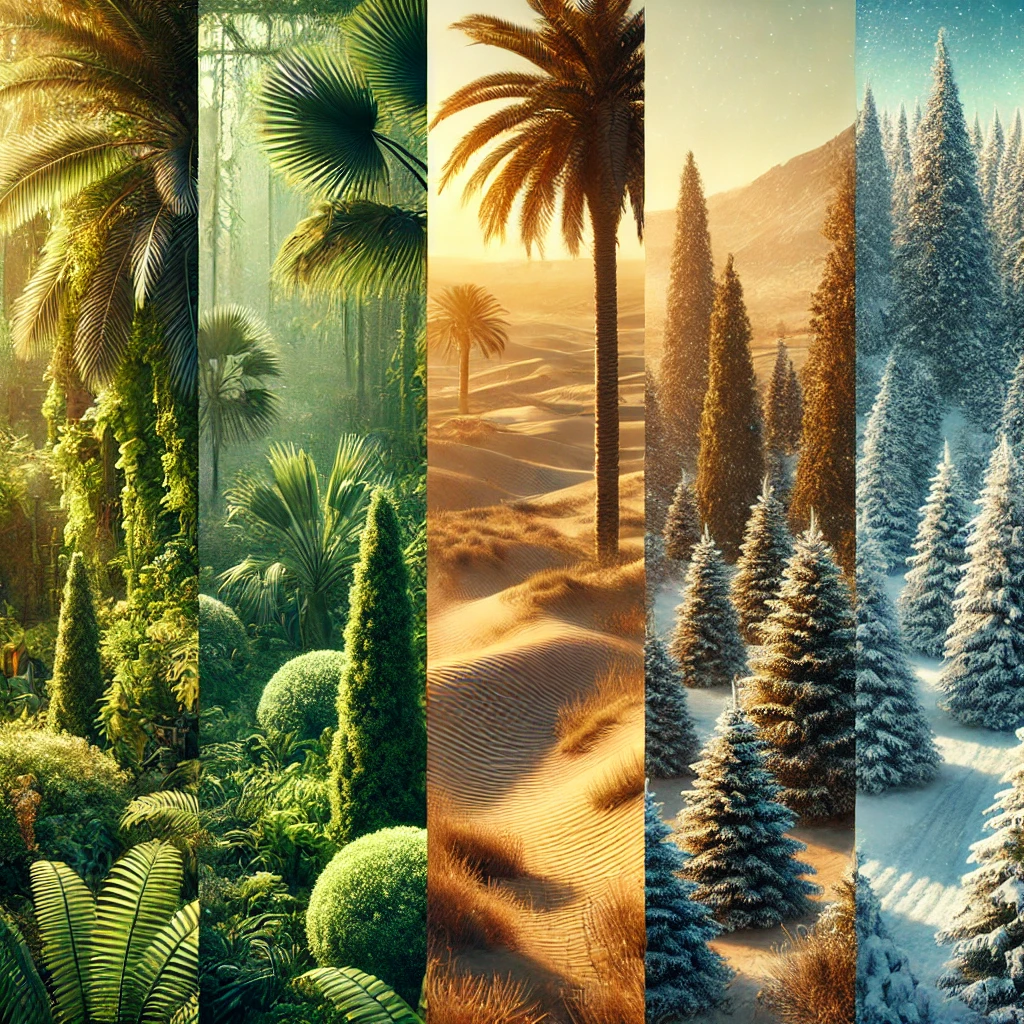
Evergreen plants thrive in various climates, from tropical regions to arid zones, offering versatility and beauty tailored to their environment. Here’s a guide to choosing the right evergreen plants based on climate conditions:
a. Evergreen Plants for Tropical Climates
Tropical climates are warm and humid, providing the ideal environment for lush and vibrant evergreen plants. Popular choices include:
- Curry Leaf Plant (Murraya koenigii): Renowned for its aromatic leaves, this plant is a staple in Indian cuisine and thrives in tropical weather.
- Mango Trees (Mangifera indica): A beloved evergreen tree that provides delicious fruits and dense shade.
- Coconut Palm (Cocos nucifera): A symbol of tropical regions, it adds an exotic flair while offering practical benefits like coconuts and coir.
b. Evergreen Plants for Temperate Climates
Temperate climates experience distinct seasons, but many evergreen plants flourish here, maintaining their foliage year-round:
- Pines (Pinus spp.): Known for their needle-like leaves and towering presence, pines are a staple in temperate landscapes.
- Spruces (Picea spp.): With their pyramid shape and vibrant green needles, spruces are ideal for decorative and windbreak purposes.
- Rhododendrons: These flowering evergreens add a burst of color to temperate gardens while keeping their lush foliage intact.
c. Evergreen Plants for Arid Climates
In arid regions with low rainfall, hardy evergreen plants adapted to drought conditions shine:
- Junipers (Juniperus spp.): Offering versatility in landscaping, junipers thrive in dry conditions with minimal water requirements.
- Yucca (Yucca spp.): Recognizable by their spiky leaves and dramatic structure, yuccas are perfect for xeriscaping.
- Agave (Agave spp.): Known for their rosette shape and succulent nature, agave plants are both ornamental and practical, with uses ranging from landscaping to tequila production.
Caring for Evergreen Plants
Proper care is essential for ensuring the health and longevity of evergreen plants. Here are some practical tips for maintaining these vibrant and resilient plants:
Soil Requirements
Evergreen plants thrive in well-drained soil that prevents waterlogging, which can lead to root rot. Enrich the soil with organic compost to enhance nutrient content and improve soil texture. This ensures the plants receive the essential nutrients they need for sustained growth.
Watering and Mulching
The watering frequency depends on the plant type and the climate. While some evergreens, like succulents, require minimal watering, others may need consistent moisture. Apply mulch around the base of the plant to retain soil moisture, regulate temperature, and suppress weeds. Mulching is especially beneficial during hot summers and cold winters.
Fertilizing
Use slow-release fertilizers to provide a steady supply of nutrients over time. Fertilize evergreen plants in early spring to support new growth and again in mid-summer for optimal health. Avoid over-fertilizing, as this can lead to excessive growth, making the plant more susceptible to pests and diseases.
Pruning
Regular pruning helps maintain the shape and health of evergreen plants. Remove dead, diseased, or damaged branches to promote better air circulation and sunlight penetration. For hedges or topiaries, pruning can also enhance their aesthetic appeal. The best time to prune is typically late winter or early spring before new growth begins.
Pest and Disease Management
Evergreen plants can sometimes face issues like aphids, spider mites, or fungal infections. Monitor plants regularly for signs of pests or diseases, such as discolored leaves or unusual growths. Use eco-friendly solutions like neem oil or homemade insecticidal soap to address minor infestations. For severe problems, consult a gardening expert for guidance.
Designing Your Space with Evergreen Plants
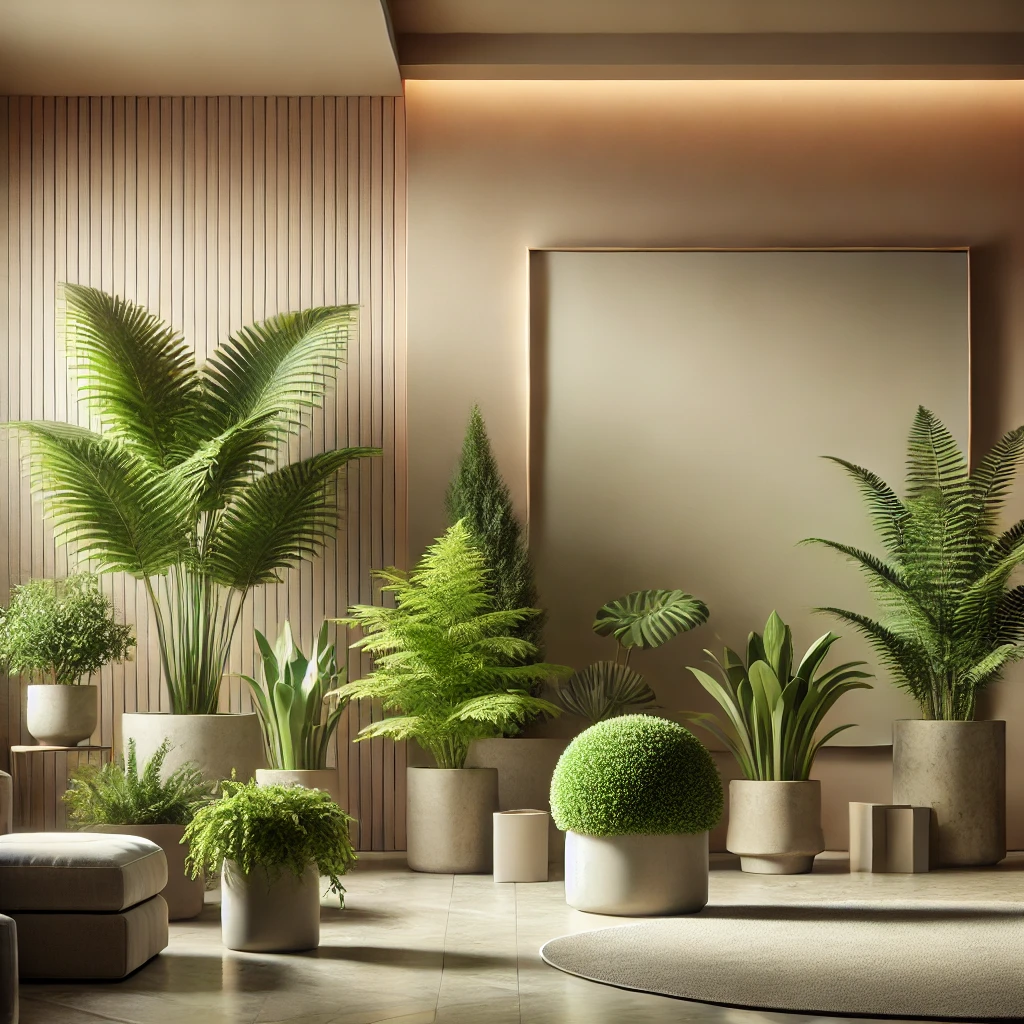
Evergreen plants offer endless possibilities for designing beautiful and functional spaces. Their year-round greenery serves as the perfect backdrop, allowing you to create stunning landscapes and indoor arrangements that stand out. Here are some practical tips and ideas for incorporating evergreen plants into your design:
Landscaping with Evergreen Trees and Shrubs
- Create Natural Fences and Privacy Screens: Use dense evergreen shrubs like Boxwood, Holly, or Indian Hawthorn to create living walls. They provide privacy, reduce noise, and enhance the aesthetic of your outdoor space.
- Define Garden Borders: Low-growing evergreens such as Barberry or Junipers are perfect for edging pathways or defining flower beds.
- Add Structure to Your Garden: Incorporate tall evergreen trees like Pines or Spruces as focal points to add vertical interest and depth.
- Layering for Visual Appeal: Combine small, medium, and tall evergreen plants to create a tiered effect that adds dimension and texture to your garden.
Creating Vertical Gardens and Green Walls with Evergreen Vines
- Maximize Vertical Space: Use evergreen vines such as Ivy or Jasmine on trellises, walls, or pergolas to make the most of limited space while adding lush greenery.
- Green Wall Installations: Build living walls indoors or outdoors using evergreen vines for a fresh and vibrant atmosphere. This is especially ideal for urban homes where horizontal space may be limited.
- Combine Functionality and Beauty: Evergreen green walls can act as natural insulation, reducing energy costs while improving air quality.
Combining Evergreen Plants with Seasonal Flowers for Year-Round Beauty
- Complementary Planting: Pair evergreen plants with flowering plants like Azaleas or Camellias to ensure year-round color. The evergreens provide a stable backdrop, while seasonal blooms add bursts of vibrancy.
- Seasonal Highlights: Rotate seasonal flowers around evergreen shrubs to keep your garden dynamic and fresh throughout the year.
- Mixed Container Arrangements: Use evergreen plants in pots alongside annuals or perennials to create versatile and mobile garden arrangements for terraces or patios.
Evergreen Plants: Myths vs. Facts
Evergreen plants are often surrounded by myths and misconceptions that can lead to confusion among gardeners and plant enthusiasts. Let’s debunk some of these myths and provide accurate insights about these remarkable plants.
Myth 1: Evergreens Don’t Lose Leaves
Fact:
While evergreen plants retain their foliage year-round, this doesn’t mean they never shed leaves. Evergreens continuously replace their old leaves with new ones, but this process is gradual and less noticeable than the seasonal shedding of deciduous plants. For example, pine trees may shed needles every 2–4 years, while broadleaf evergreens like holly may drop older leaves during spring growth.
Myth 2: Evergreens Only Thrive in Cold Climates
Fact:
Evergreens are versatile and grow in various climates, from cold regions to tropical areas. While conifers like spruces and firs dominate colder climates, tropical evergreens like curry leaf plants and areca palms thrive in warmer regions, showcasing their adaptability to diverse environmental conditions.
Myth 3: Evergreens Require Little to No Maintenance
Fact:
Although evergreen plants are generally low-maintenance, they still require care to thrive. Proper watering, occasional pruning, fertilization, and pest control are essential for healthy growth. Ignoring these needs can lead to stunted growth, pest infestations, or nutrient deficiencies.
Myth 4: All Evergreens Are Conifers
Fact:
Evergreens are not limited to conifers like pines and cedars. Many broadleaf plants, such as camellias, boxwood, and jasmine, are also evergreen, offering a variety of leaf shapes and textures. This diversity makes them suitable for different aesthetic and functional uses in gardens and landscapes.
Myth 5: Evergreens Are Immune to Pests and Diseases
Fact:
Like all plants, evergreens can face pest and disease issues. Common problems include scale insects, spider mites, and fungal infections. Regular monitoring and eco-friendly pest control measures are crucial to maintaining their health and beauty.
Myth 6: Evergreens Don’t Flower
Fact:
Many evergreen plants produce beautiful flowers. Examples include camellias, with their vibrant winter blooms, and jasmine, which offers fragrant blossoms. These flowering evergreens add both greenery and seasonal bursts of color to gardens and spaces.
By addressing these common myths and presenting the facts, you can better understand and care for evergreen plants. This knowledge helps you make informed decisions when incorporating them into your garden, terrace, or indoor spaces.
Top Evergreen Plants to Consider
Here’s a curated list of popular evergreen plants, categorized for various spaces like indoor, outdoor, gardens, and terraces. These plants ensure year-round greenery while enhancing the beauty of your environment.
1. Indoor Evergreen Plants
| Plant Name | Description | Care Tips |
|---|---|---|
| Snake Plant | Known for its upright, sword-like leaves, it’s perfect for air purification and low-light areas. | Minimal watering, indirect light. |
| Rubber Plant | Features broad, glossy leaves that add a contemporary touch to interiors. | Moderate watering, bright light. |
| Peace Lily | Offers lush green leaves and occasional white blooms, enhancing indoor aesthetics. | Keep soil moist, indirect sunlight. |
2. Outdoor Evergreen Shrubs
| Plant Name | Description | Ideal Use |
|---|---|---|
| Boxwood | A versatile shrub with dense foliage, ideal for hedges and topiary. | Hedges, borders. |
| Camellia | Produces vibrant blooms in winter or early spring, with glossy green leaves. | Standalone or mixed shrub borders. |
| Indian Hawthorn | Compact shrub with pink or white blossoms, perfect for warm climates. | Hedges, decorative planting. |
3. Evergreen Trees
| Plant Name | Description | Best Suitability |
|---|---|---|
| Pine Tree | A conifer with needle-like leaves, suitable for large gardens or landscapes. | Large gardens, windbreaks. |
| Cedar Tree | Offers a majestic structure and aromatic wood, adding character to outdoor spaces. | Landscapes, focal points. |
| Mango Tree | A tropical evergreen providing shade and delicious fruits. | Tropical gardens. |
4. Terrace Evergreen Plants
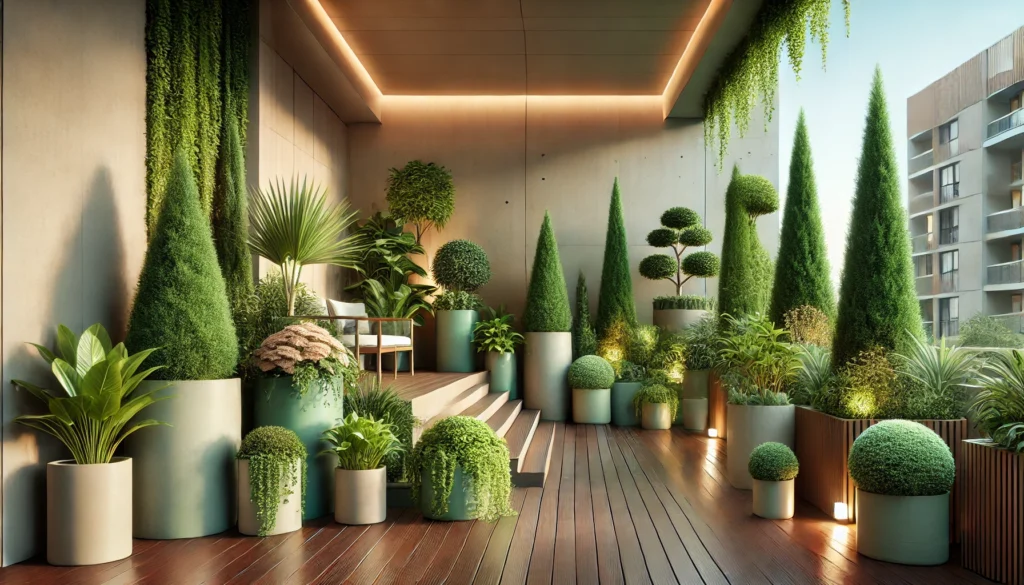
| Plant Name | Description | Care Tips |
|---|---|---|
| Areca Palm | A popular choice for terraces, it brings a tropical vibe with its feathery fronds. | Regular watering, indirect sunlight. |
| Croton Petra | Adds a vibrant pop of color with its multicolored leaves. | Needs bright light, moderate water. |
| Ixora | Compact shrub with year-round flowers in warm climates, great for pots. | Full sun, well-drained soil. |
5. Evergreen Vines
| Plant Name | Description | Ideal Use |
|---|---|---|
| Ivy | A fast-growing climber that provides excellent ground cover or wall greenery. | Green walls, trellises. |
| Jasmine | Known for its fragrant white flowers, perfect for pergolas or fences. | Decorative and aromatic trellises. |
This detailed list ensures you can choose the perfect evergreen plant for your needs, whether it’s enhancing indoor spaces, creating a vibrant terrace garden, or adding character to your outdoor landscape.
FAQs About Evergreen Plants
What are the easiest evergreen plants to grow?
Some of the easiest evergreen plants to grow include Snake Plant, Areca Palm, and Boxwood. These plants require minimal care, thrive in various conditions, and are resilient against pests and diseases.
Can evergreen plants survive in pots?
Yes, many evergreen plants can thrive in pots. Examples include Rubber Plant, Peace Lily, and Croton Petra. Ensure proper drainage, use nutrient-rich soil, and choose pots that accommodate the plant’s root growth.
How do I choose the best evergreen plant for my space?
Consider factors such as the available sunlight, climate, soil type, and the plant’s mature size. For indoor spaces, go for low-light tolerant plants like the Snake Plant. For gardens, choose shrubs like Boxwood or flowering plants like Azalea.
How to maintain evergreen plants during winter?
In winter, reduce watering as plants require less moisture. Mulch around the base to protect roots from frost. For potted plants, bring them indoors or cover them during extreme cold. Pruning dead or damaged branches helps maintain health.
Are there flowering evergreen plants?
Yes, many evergreen plants produce beautiful flowers. Popular examples include Camellia, Azalea, and Arabian Jasmine, which combine year-round greenery with seasonal blooms.
Which plant is evergreen?
Evergreen plants include Pine, Holly, Ivy, and Areca Palm, to name a few. These plants retain their leaves throughout the year and are a great choice for consistent greenery.
What are evergreen plants Class 4?
For Class 4 students, evergreen plants can be explained as those that remain green and fresh all year. Examples include Neem, Mango, and Coconut trees. These plants are essential for providing shade, oxygen, and beauty to our surroundings.
What is called an evergreen?
An evergreen is any plant that retains its foliage throughout the year. Unlike deciduous plants, evergreens do not shed all their leaves at once, making them an excellent choice for year-round greenery.
Conclusion
Evergreen plants are more than just a landscaping choice; they are a year-round symbol of life and beauty. Their ability to retain foliage through every season makes them a cornerstone of garden design and indoor décor. Whether you’re looking to add greenery to your home, create a private oasis in your garden, or design a vibrant terrace space, evergreen plants are the perfect solution.
Incorporating these plants into your surroundings not only enhances aesthetics but also contributes to environmental well-being by improving air quality and providing habitats for wildlife. From hardy shrubs to elegant indoor varieties, the versatility of evergreen plants ensures there’s something for every space and style.
If you haven’t already, consider adding evergreen plants to your space to enjoy their lasting charm and benefits. Share your experiences with these year-round beauties in the comments below or on social media—we’d love to hear how you’ve transformed your space with evergreen plants!

